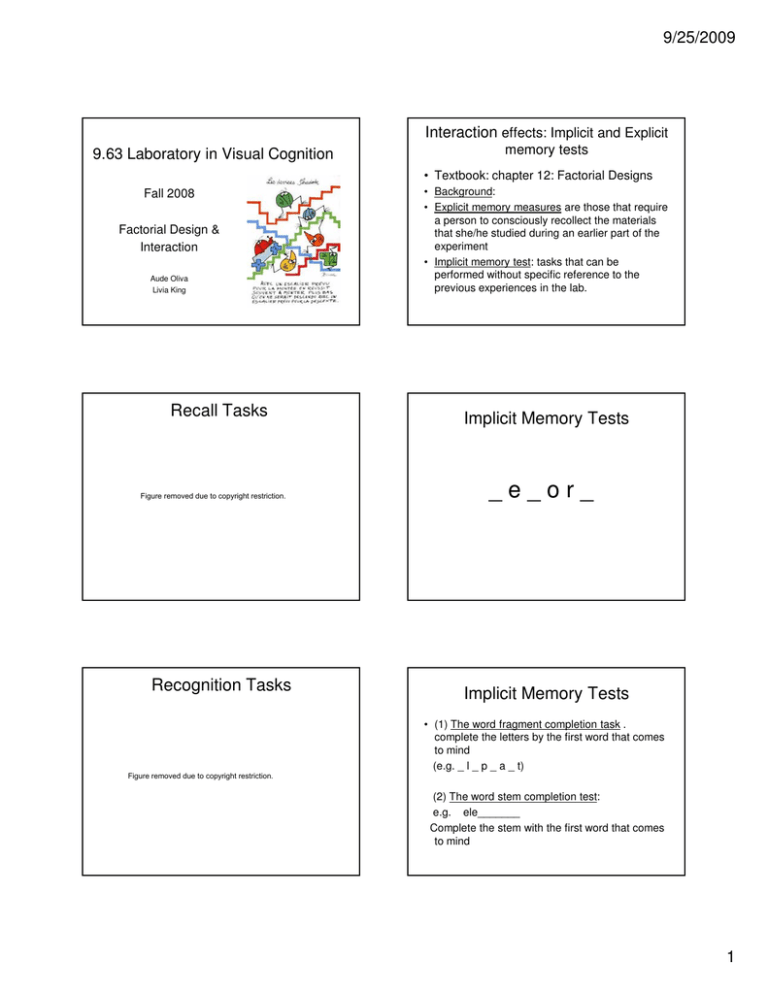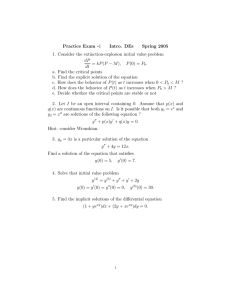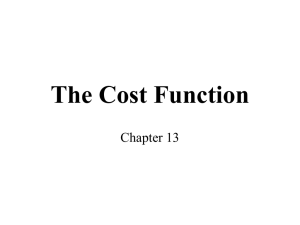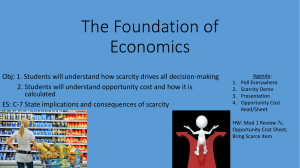Document 13509099
advertisement

9/25/2009 Interaction effects: Implicit and Explicit 9.63 Laboratory in Visual Cognition memory tests • Textbook: chapter 12: Factorial Designs Fall 2008 Factorial Design & Interaction Aude Oliva Livia King Recall Tasks Figure removed due to copyright restriction. Recognition Tasks • Background: • Explicit memory measures are those that require a person to consciously recollect the materials that she/he studied during an earlier part of the experiment • Implicit memory test: tasks that can be performed without specific reference to the previous experiences in the lab. Implicit Memory Tests _e_or_ Implicit Memory Tests • (1) The word fragment completion task . complete the letters by the first word that comes to mind (e.g. _ l _ p _ a _ t) Figure removed due to copyright restriction. (2) The word stem completion test: e.g. ele_______ Complete the stem with the first word that comes to mind 1 9/25/2009 Word completion study • • The facilitation to supply the missing information is called priming Fragments of words can be from new words or words previously seen. Subjects are not told that some words might have been in the initial list (this is an implicit memory test). Priming for fragments completion does not decrease (much) over time (hours vs. days) But performance in a recognition task (explicit test) does decrease over time • • Word fragment completion performance 100 Amnesia • Amnesia: deficits in memory as a function of brain damage, disease or psychological trauma Amnesia can involve either the inability to learn new things or a loss of previous knowledge, or both Amnesia can differentially Figure removed due to copyright restriction. affect short-term/working • Pigeon Animal Percent correct Table A_I_A H_ _SE Automobile Tree • Camera Quarter Boot 0 Previously seen New Delay period Word type memory and long term memory abilities Amnesia types and the type of memory tests can show all types of interaction between 2 variables Previously seen word list • A typical word-printing study subjects are shown lists of words and than wait varying amounts of time to perform & fragment completion task. Tulving and Schacter (1990) showed that subjects are better at completing fragments of words that were previously shown to them. Figure by MIT OpenCourseWare. Amnesia Interaction • Retrograde amnesia Impairment of memories before onset (lost of memory for events prior to whatever trauma) • Anterograde amnesia – Impairment of memories after onset (difficulty in remembering events after the trauma) – Patient H.M. – Movie: Memento • Goal: In an experiment, you compare the explicit and implicit memory of amnesic and control subjects. • Experiment design (2 x 2): Amnesic patients and control subjects studied 24 words. • Factor 1: Group (amnesic vs. control) • Factor 2: Type of memory test: implicit (word identification) explicit (free recall) Word identification test: subjects saw perceptually degraded word (pieces of each letter were obliterated) and were instructed to name the word (measure of priming) • Dependent variable: Proportion of correct responses Figure removed due to copyright restriction. Interaction A 0.6 Interaction A 0.6 0.6 0.5 0.5 0.4 0.4 0.4 0.4 0.3 0.3 0.3 0.3 0.2 0.2 0.2 0.2 0.1 0.1 Controls Amnesics 0.5 0.1 Controls Amnesics 0.1 0 0 Explicit test Implicit test 0.6 Controls Amnesics 0 Explicit test Implicit test What is the main effect of factor “group”? What is the main effect of factor “type of tests”? Describe the interaction 0.5 Controls Amnesics 0 Explicit test Implicit test Explicit test Implicit test There is no interaction between the variables. Main effect of types of subjects: the control group perform better than the amnesics on both the explicit and implicit tests. 2 9/25/2009 Interaction B 0.6 Interaction B 0.6 0.6 0.5 0.5 0.5 0.5 0.4 0.4 0.4 0.4 0.3 0.3 0.3 0.3 0.2 0.2 0.2 0.2 0.1 0.1 Controls Amnesics 0.1 Controls Amnesics 0.1 0 0 Explicit test Controls Amnesics 0 Implicit test Explicit test 0.6 Controls Amnesics 0 Implicit test Explicit test Implicit test Explicit test Implicit test What is the main effect of factor “group”? What is the main effect of factor “type of tests”? Describe the interaction Interaction: controls performed better than amnesics on the explicit free recall test. But amnesics perform as well as controls on the implicit test. The difference between amnesic and control group disappears when memory is measured implicitly. -> the effect of one independent variable (presence or absence of a memory deficit) changes depending on the level of the other independent variable (test type) Interaction C Interaction C 0.6 0.6 0.6 0.5 0.5 0.4 0.4 0.4 0.4 0.3 0.3 0.3 0.3 0.2 0.2 0.2 0.2 0.1 0.1 Controls Amnesics 0.5 0.1 Controls Amnesics 0.1 0 0 Explicit test Implicit test Implicit test Implicit test Implicit test Interaction D 0.7 Controls Amnesics 0.7 0.6 0.6 0.6 0.5 0.5 0.4 0.4 0.3 0.3 0.2 0.2 0.1 0.1 0 Controls Amnesics 0 Explicit test Explicit test A cross over interaction: the control show better memory than amnesics on the explicit test. But the amnesics show better memory than the controls on the implicit test. 0.7 Controls Amnesics Controls Amnesics 0 Explicit test Interaction D 0.6 0.5 0 Explicit test What is the main effect of factor “group”? What is the main effect of factor “type of tests”? Describe the interaction 0.7 0.6 Controls Amnesics Implicit test 0.5 0.5 0.4 0.4 0.3 0.3 0.2 0.2 0.1 0.1 0 0 Explicit test Explicit test Implicit test Controls Amnesics Explicit test Implicit test Implicit test What is the main effect of factor “group”? What is the main effect of factor “type of tests”? Describe the interaction Interaction: the amnesic deficit is more pronounced on the explicit test than on the implicit test. Although control subjects performed substantially better than amnesics on the implicit test, the superiority of control’s memory to amnesics’ memory is even greater on the explicit test. These data would suggest that the implicit test is a less sensitive measure of amnesic deficits than is the explicit test. 3 9/25/2009 Amnesia and Memory Warrington & Weiskrantz -A­ Amnesia and Memory Warrington & Weiskrantz -B- 0.6 0. 6 0.5 0. 5 0.4 0. 4 0.3 0. 3 0.2 Controls Amnesics 0.1 0. 2 Controls Amnesics 0. 1 0 Explicit test Implicit test 0 Explicit test -C­ Implicit test -D- 0.6 0.7 0.5 0.6 0.4 0.3 0.3 0.2 0.2 Controls Amnesics 0.1 Controls Amnesics 0.1 0 0.6 0.5 0.4 0.3 0.2 Controls Amnesics 0.1 0.5 0.4 Interpretation: Although amnesic perform poorly on the explicit recall test, the amount of priming they showed on the word fragment recognition task was identical to performances of normal subjects. Conclusion: the amnesic’s problem seems to lie in gaining conscious access to these stored experiences. 0 Explicit test Implicit test 0 Implicit test Explicit test Implicit test Memory and Normal subjects Memory and Normal subjects • • Weldon and Roediger (1987) studied the picture superiority effect, the finding that pictures are remembered better than words. • Theory: this effect of pictures has typically only been studied with explicit memory test (recall and recognition). • Here the authors wanted to extend the study to implicit tests • Hypothesis: The picture superiority effect would not be found on implicit tests • • • • • Memory and Normal subjects Proportion correct (priming effect) Word fragment completion 0.3 0.25 0.4 Free recall 0.4 Pictures words 0.35 Priming effect 0.4 Memory and Normal subjects Proportion correct (priming effect) Free recall 0.35 College students studied along series of pictures and of words in anticipation of a later memory test. There were three sets of items: subjects studies one set as pictures and one set as words and did not study the third set. The items sets were counterbalanced across subjects, so that if subjects in one group saw a picture of an elephant, those in another group saw the word elephant, and those in a third group did not see the item in neither form. After studying the words and pictures, subjects took either an explicit free recall test or an implicit word fragment completion test. In the free recall test, subjects were given a blank sheet of paper and asked to recall the names of the pictures and words as well as possible. In the word fragment completion test, subjects were given a series of fragmented words (e.g. _l_p_a_t) and told to complete each one with a word. Here the measure of interest was priming – the advantage in completing a fragment when its prior presentation was either a picture or a word, relative to the case when neither form has been studied. 0.35 0.3 0.3 0.25 0.25 Word fragment completion 0.4 0.3 0.25 0.2 0.2 0.15 0.15 0.1 0.1 0.1 0.1 0.05 0.05 0.05 0.05 0 0 0.2 0.15 Pictures Words 0 Free recall word fragment completion - Is there a main effect of mode of presentation ? (pictures vs. words) - Is there a main effect of type of tasks? (free recall vs. word completion) - Is there an interaction? Pictures words 0.35 Priming effect Explicit test 0.2 0.15 0 Pictures Words Free recall word fragment completion Interpretation: There is an interaction (crossover interaction) between explicit (free recall) and implicit (fragment completion) retention in normal subjects. Conclusion: Words produced more priming than pictures on the implicit word fragment completion test. 4 9/25/2009 Higher Order Interaction Memory: Factors Multifactor design • Multi-factor experiments are preferable to single factor experiments because they help answering the question of generality (under which conditions the effects observed are true?) • When the nature of an interaction between two variables changes depending on the level of a third variable, the interaction is referred to as a higher-order interaction • Factor 1: Test type (implicit vs. explicit) • Factor 2: memory deficit (control population vs. amnesic patient) • Factor 3: level of encoding • 1- Low: count the number of vowels in each word • 2- High: form a sentence using each word Proportion correct Higher Order Interaction Memory: Hypothetical Results Proportion correct Proportion correct Explicit Test 0.7 0.7 0.6 0.6 0.5 0.5 0.7 0.7 0.6 0.6 0.5 0.5 0.4 0.4 0.4 0.3 0.3 0.3 0.3 0.2 0.2 0.2 0.2 0.4 0.1 0.1 0.1 0 Amnesics Controls Amnesics Low level of encoding (graphemic task) 0.6 0.5 0.5 0.4 0.4 0.3 0.3 0.2 0.2 0.1 0.1 0 0 Controls Amnesics • Controls Amnesics Low level of encoding (graphemic task) 0.1 0 0 Controls 0.7 0.6 Implicit Test Explicit Test Implicit Test • • Implicit Test Explicit Test 0.7 • Proportion correct 0 Controls Amnesics Controls Amnesics High level of encoding (Semantic task) Interpretation? Explicit Test 0.7 0.6 0.6 0.5 0.5 0.4 0.4 0.3 0.3 0.2 0.2 0.1 0.1 0 0 Controls • Implicit Test 0.7 Amnesics • Controls Amnesics Interpretation Higher-order interaction between the 3 factors: When the controls subjects study the words by forming sentences, they recall more words on the explicit recall test than when they simply count the vowels. The amnesics do not show this improvement in performance on the explicit test. On the implicit test, there is no change in performance for either the controls or the amnesics when they study the words by forming sentences. Therefore, manipulation of a third variable (level of encoding) changes the nature of the interaction between the two other variables. High level of encoding (Semantic task) Interaction interpretation • • • • • • • • • Subjects were presented with 36 non words trigrams (NTG), one at a time. Factor 1: Modality of presentation 1) Auditory + Visual 2) Auditory only 3) Visual only Factor 2: Retention interval (before starting reporting the trigrams) 0,3,6,9,12 or 18 seconds (6 levels) Task: a free recall task of the trigram Method: 1 trigram is presented; 1 second delay; subjects heard a 3 digits number (except in the zero interval condition); subjects were asked to count backgrounds per threes aloud; after the retention interval, participants recall the trigram. • Dependent variable: proportion of correct report How do you interpret the results? Is there an interaction? Proportion of correctly recall trigram 1 0.9 0.8 0.7 0.6 0.5 0.4 0.3 0.2 0.1 0 Auditory+Visual Auditory only Visual only 1 2 3 4 5 6 Retention interval (second) 5 9/25/2009 Issue with interaction interpretation • Problem: performance at the 0 second retention interval is very nearly perfect in all conditions. When performance is perfect (ceiling effect) it is impossible to tell whether there are any real differences among conditions because of the scale attenuation. 1 0.9 0.8 0.7 0.6 0.5 0.4 0.3 0.2 0.1 0 Auditory+Visual Auditory only Visual only 1 2 3 4 5 6 • General Rule about interaction: Extreme caution should be used in interpreting interactions where performance on the dependent variable is at either the floor or the ceiling at some level of one of the independent variable Higher Order Interaction Exercise • Question How can the physical characteristics of a person influence judgments of how guilty you think a person is? • Factor 1 Attractiveness: Attractive vs. Unattractive • Factor 2 facial expression: neutral vs. smiling • Exercise: Find a 3rd relevant factor (2 levels) related to the question Figure by MIT OpenCourseWare. Higher Order Interaction Attraction X Emotion Level of guiltiness An unattractive face is judged less guilty if it is smiling, but An attractive face is judge less guilty if it has a neutral expression. Higher Order Interaction Attraction X Emotion X 3rd factor Attractive Unattractive 3rd factor level 1 Statistics analysis for factor design • • • • When an experiment has: - a single factor with 3 or more levels - 2 or more factors Statistical test: Analysis of Variance • The heart of the ANOVA is a comparison of variance estimates between your conditions (groups) Attractive Unattractive 3rd factor level 2 ANOVA • In the ANOVA, two independent estimates of variance are obtained: • (1) Between groups variance: based on the variability between the different experimental groups – how much the means of the different group differ from one another. Actually, the variance is computed as to how much the individual group means differ from the overall mean of all scores in the experiment. • (2) Within groups variance: give an estimate of how much the participants in a group differ from one another (or the mean of the group) 6 9/25/2009 ANOVA ANOVA • Basic idea: are the scores of the different groups or conditions reliable different from each other? • Null hypothesis: all the participants in the various conditions are drawn from the same population: the experimental variable has no effect. • Consequence of the null hypothesis on the between and within variance? • Basic idea: are the scores of the different groups or conditions reliable different from each other? • Null hypothesis: all the participants in the various conditions are drawn from the same population: the experimental variable has no effect. • Consequence of the null hypothesis: the between group variance should be the same as the between group variance ANOVA ANOVA • To reject the null hypothesis, the means of the different groups must vary from one another more than the scores vary within the groups • The greater the variance (differences) between the groups of the experiment, the more likely the independent variable is to have had an effect, especially if the within group variance is low • Under the null hypothesis, the F ratio should be ? • The greater the between groups variance is than the within group variance and consequently, the greater the F ratio is than 1.00, the more confident we can be in rejecting the null hypothesis. • The F test is simply a ratio of the between groups variance estimate to the within-groups variance estimate Between-groups variance Between-groups variance F = ----------------------------­ F = ----------------------------­ Within-groups variance Within-groups variance Statistics Test at a glance One Factor with 2 levels Statistics Test at a glance One Factor with more than 2 levels Mann-Whitney Between-Subjects t Wilcoxon Ordinal Data Interval/Ratio Data Ordinal Data Within-Subjects t Interval/Ratio Data Box B-6 One-way Between-Subjects ANOVA Interval/Ratio Data Between-Subjects Design One-way Within-Subjects ANOVA Interval/Ratio Data Within-Subjects Design Between-Subjects Design I have one independent variable that has two levels? t-test Box B-7 t-test Figure by MIT OpenCourseWare. Within-Subjects Design I have one independent variable that has more than two levels? Figure by MIT OpenCourseWare. 7 9/25/2009 Statistics Test at a glance Two Factors with at least 2 levels each Box B-8 n X n Factorial ANOVA Interval/Ratio Data Between-Subjects Design Box B-9 Within-Subjects Factorial ANOVA Interval/Ratio Data Within-Subjects Design I have one independent variable, each with at least two levels? Figure by MIT OpenCourseWare. 8 MIT OpenCourseWare http://ocw.mit.edu 9.63 Laboratory in Visual Cognition Fall 2009 For information about citing these materials or our Terms of Use, visit: http://ocw.mit.edu/terms.



